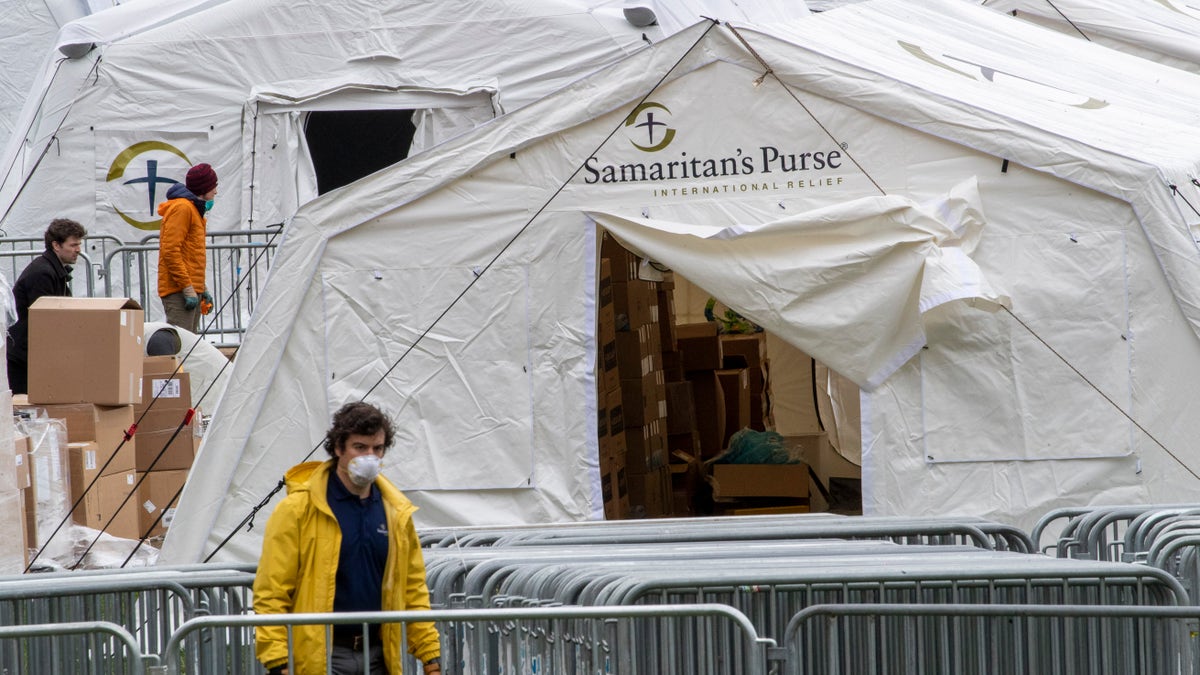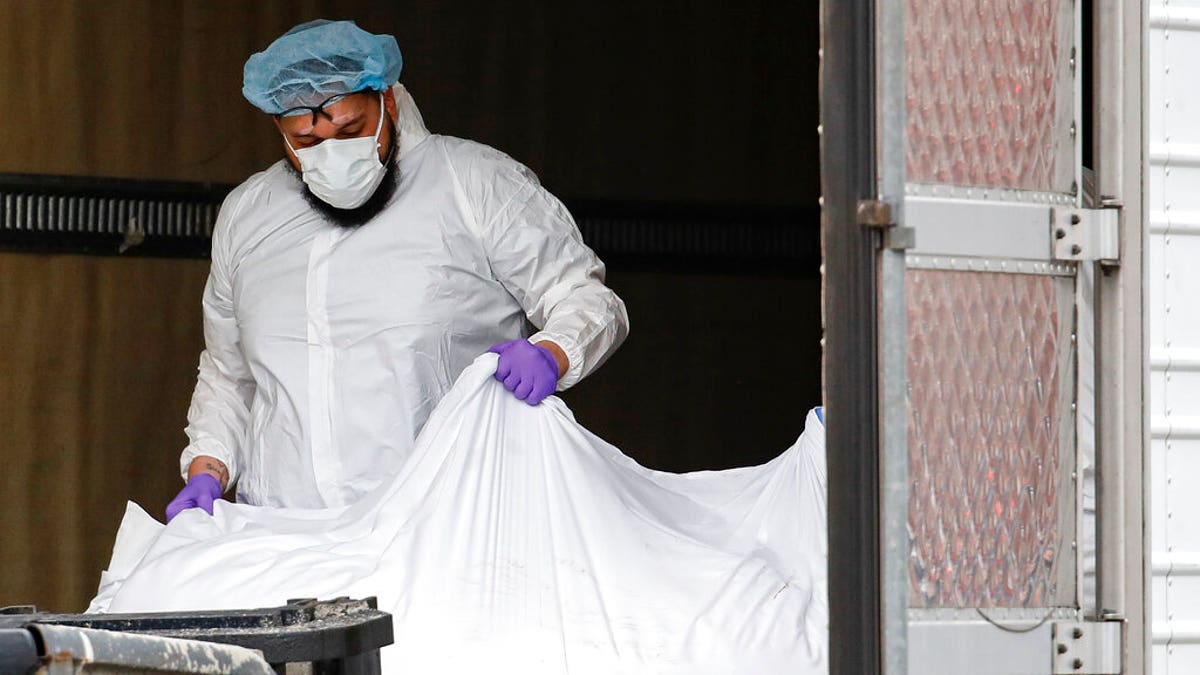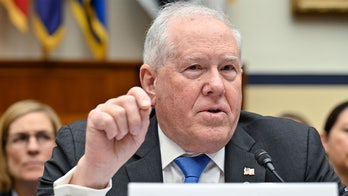Cuomo critics highlight years of taxpayer waste, amid deepening coronavirus crisis in New York
Critics of New York Governor Andrew Cuomo have brought to attention his years of fiscal mismanagement and cost-cutting that have worsened the state’s healthcare system. Check out how this is causing a major burden for the state amid the COVID-19 pandemic.
Get all the latest news on coronavirus and more delivered daily to your inbox. Sign up here.
While coronavirus ravages New York – with officials desperately clamoring for life-saving supplies and federal assistance – attention has also turned to years of fiscal mismanagement and cost-cutting, despite it being one of the highest-taxed states in the country.
Since the outbreak gained a foothold in the United States earlier this year – and quickly spawned across New York, a state of 19.5 million people – Democratic Gov. Andrew Cuomo has appealed for support. He has also criticized the Trump administration's handling of the pandemic.
CORONAVIRUS' FRIGHTENING PROFILE: WHO IS MORE LIKELY TO DIE FROM COVID-19?
But critics contend Cuomo also needs to look closer to home.
"Although the public is only now becoming aware of the problem, emergency room shortages have long plagued the state's healthcare system. In addition, New York bypassed an opportunity five years ago to purchase 16,000 ventilators at a total cost of under $600 million," Joel Griffith, a research fellow at the conservative Heritage Foundation, told Fox News.
"This sum represented just 0.4 percent of the 2015-2016 enacted budgetvc— a year in which more than $2.3 billion was set aside for 'economic development,' an amorphous category riddled with cronyism. This potential shortage was both avoidable and warned about," he said.
The governor, who has held the top job since 2011, has said that the state needs at least 30,000 ventilators – and an extra 50,000 hospital beds – to brace for the pinnacle of the storm in the coming weeks. As it stands, New York is currently the global epicenter of coronavirus, which causes the disease COVID-19. The state has had more than 84,000 confirmed cases, some 2,000 deaths, and over 12,000 hospitalizations – more than a quarter in the intensive care unit – and the ominous numbers are rising by the minute.
Manny Alicandro, a New York-based attorney who specializes in policy and politics, also noted that New York started the fiscal year facing a $6 billion budget gap, the worst since 2011 — and much of the state and city officials have been mostly "distracted with social issues such as banning plastic bags, bail reform and failed alternative energy policies."
"It is sad that after 9/11 and Hurricane Sandy, New York state and New York City remained so unprepared to deal with any crisis, especially something like the coronavirus," he continued.
And Alexandra Abrams, of the watchdog group Citizens Against Government Waste (CAGW), emphasized that while no one was fully prepared for the sudden and swift onset of the virus, "New York had ignored requests from Comptroller Thomas DiNapoli to be ready for a serious problem before it occurred."
"He had been asking the state for years to put in place better safeguards and create a reserve fund. The Pew Foundation reported that in the fiscal year 2019, the state had a reserve fund that could help for 26.1 days, which is two weeks lower than the national median," she said. "Comptroller DiNapoli projected that tax collections could miss the target amount by up to $7 billion."
CLICK FOR COMPLETE COVERAGE OF THE CORONAVIRUS OUTBREAK
In his most sobering press conference to date, President Trump on Tuesday cautioned the American people that we are all in for a grim couple of weeks ahead – with estimates indicating that up to 240,000 lives could be lost as a result of the novel pathogen. On the same day, Cuomo blasted the federal government for inciting an "e-Bay"-like bidding war for ventilators. The machines are critical in the coronavirus fight given that the contagion attacks the lungs; thus, infected persons often require a ventilator to breathe.

A Samaritan's Purse crew and medical personnel work on preparing to open a 68 bed emergency field hospital specially equipped with a respiratory unit in New York's Central Park, Tuesday, March 31, 2020, in New York. (AP Photo/Mary Altaffer)
Some critics have also expressed skepticism that the state's taxes will only exacerbate economic hardship as the health crisis rages. According to a review in the New York Post, Albany already adds a 9.6 percent surcharge to hospital bills, paid for by the patient. Employers covering insurance costs are also slapped with an extra fee, which is determined in the form of an in-person assessment.
The "penalizing people for getting sick" commission brings in around $5 billion for the state, the Post claimed, "making such a fee the third-largest source of revenue after income and sales taxes."

A body wrapped in plastic is loaded onto a refrigerated container truck used as a temporary morgue by medical workers wearing personal protective equipment due to COVID-19 concerns, Tuesday, March 31, 2020, at Brooklyn Hospital Center in the Brooklyn borough of New York. (AP Photo/John Minchillo)
The state's track record for apparent fiscal exhaustion has been brought to the forefront countless times over the years. Cuomo was condemned two years ago after he reportedly ordered that the money-beggared MTA spend around $30 million on retiling two city tunnels with the state's blue-and-gold motif rather than using the funds for much-needed repairs.
In 2018, critics also called Cuomo out for massive overspending on endeavors that did not see the light of day.
For one, there were the millions injected into a solar-panel factory, which was touted as becoming the largest manufacturing facility in the nation, only to be taken over by Tesla which scaled back solar endeavors, leaving its future – and the reported $50 million paid for by New Yorkers – in limbo.
And then there was a 2014 partnership with California light bulb company Soraa, which saw a $90 million factory erected outside Syracuse, only for the business deal to go bust and a taxpayer-financed factory with lights that failed to flicker on. Many also lamented the millions spent on putting up 500 "I Love New York" promotions signs across state highways, despite being called a violation of state and federal highway safety regulations.
"Just last year we saw Governor Cuomo allocate $30 million to provide college tuition to those here illegally – that's $30 million worth of ventilators and personal protective equipment that we can't send to our heroes working on the front lines during this pandemic today," argued GOP Assemblyman Mike LiPetri, who currently serves in New York's 9th district. "Governor Cuomo likes to tout his 'excelsior' motto – onward and upward he says – when the sad reality is his history of mismanagement, and misguided policies have kept us firmly planted in the difficult situation we face here today."
A 2019 Market Review examination of New York's fiscal health pointed out that almost all "governments spend money like it's going out of style, with very little regard to the long-term consequences."

The Empire State Building is illuminated to honor emergency workers, during the outbreak of coronavirus disease (COVID-19), in Manhattan, New York City, U.S. March 30, 2020, in this picture obtained from social media. (TWITTER/WADE HOWELL/via REUTERS)
But New York, on both a city and state level, is already at the top of the nation in terms of local and state tax burdens.
"New Yorkers pay the highest state and local business taxes in the nation, the second-highest individual income taxes, the highest workers, compensation costs, and the fifth-highest property taxes. Don't expect a lightening of these economic burdens anytime soon," Griffith said. "The state's underfunded public sector pensions represent financial time bombs which will require a combination of higher taxes and diminished essential government services—such as emergency medical responses and functioning mass transit."
Nonetheless, Mayor Bill de Blasio has warned that the city's hospitals could go broke from coronavirus, flagging that without federal funds, "they can't pay the bills, health care will decline rapidly."
In late January, when the virus was still circulating silently and weeks before most of the country was forced into lockdown, a Chicago-based municipal finance watchdog, Truth in Accounting (TIA), documented that 63 out of 75 of the country's most populous cities do not have the bankroll to foot all their bills.
Based on their grading methodology and then published by Forbes, New York was characterized as the city "in the worst fiscal condition," followed by Chicago, Philadelphia, Honolulu, and San Francisco. The report labeled New York as the worst "because of its significant and growing liabilities," highlighting that it "has only 58.5 billion in assets to pay $244 billion in liabilities." Moreover, New York City had only put aside $4.7 billion to fund the $100.6 billion of pledged retiree benefits, thus burgeoning every resident's tax amount by an average of $1600 per year every year since 2016.
The TIA accused the city of "not being as transparent as it should be," indicating that $312.3 million of pension debt was being obscured from its balance sheet.
BIDEN OFFERS TO CALL TRUMP AT WHITE HOUSE TO DISCUSS CORONAVIRUS RESPONSE STRATEGY
But on the flipside, Cuomo has been broadly praised for his firm, collected and statesmanlike approach to fighting the disease's onslaught, even earning praise by a number of New York Republican figures.
"I believe that the governor has been doing a good job. This is not an easy task for anyone in any position," Rep. Lee Zelden, R-N.Y, told Fox News. "There have been many political issues where I have battled him. But fast-forward to 2020, we're not Republicans or Democrats. We are New Yorkers. We are Americans."
Rep. Peter King, R-N.Y, concurred that Cuomo is "doing a good job as far as managing the state right now," and ultimately "moving the equipment in" and getting what he wants out of his frequent sparring with Trump.

President Trump praised New York Gov. Andrew Cuomo for his handling of the coronavirus in the state. (Associated Press)
Analysts have also underscored in recent days that although New York is taking the brunt of the coronavirus pandemic, the state is due to receive only 5 percent of a $150 billion "relief fund" established in Washington.
"The state's allocation is so low because the federal funds are distributed by population, not need, and even the smallest state is guaranteed at least $1.25 billion," the policy-focused Empire Center surmised.
Cuomo also highlighted that the allocation was skewed and not in New York's favor in a press briefing on Sunday, stressing that of the bill passed last week, the state gets around 1.9 percent of the state budget, about $5 billion, to use for coronavirus expenses.
"Since taking office Cuomo has burned taxpayer's money on his campaigns and new business deals upstate, all whilst offering multi-million dollar companies tax breaks," opined Ken Mahoney, CEO of New York-based Mahony Asset Management, while at the same time highlighting the predicament the coronavirus-saturated city is in despite the stimulus package. "The $2T stimulus package should help repair the economy, but here in New York, we have got the short straw as there are twice as many cases for the same amount of support."
The fund was part of the $2 trillion Coronavirus Aid, Relief and Security Act, or CARES Act, which was drafted in the Senate last month, passed by both houses and signed by President Trump on Friday.
"New York and other states could have invested more heavily in medical supplies, but I am not sure New York had any particularly good options," added Stan Veuger, an economist with the American Enterprise Institute (AEI). "States and localities have been flying blind in large part because the federal government completely dropped the ball on the testing front."
Fox News' Marisa Schultz contributed to this report.





